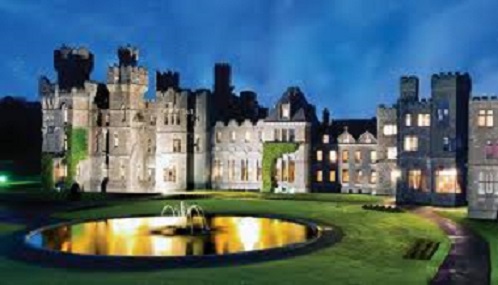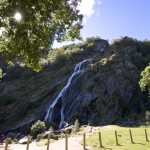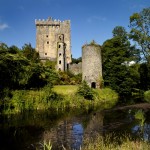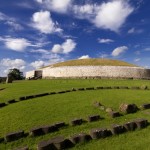This Luxury 5 star Hotel & Castles tour includes stays at Ireland’s premier hotels .
Spend your honeymoon in Ireland. Stay in an Irish Castle. Make the most out of your trip and travel Ireland.
Wake up to find yourself staying at some of Ireland’s most lavish Hotels & Castles. Explore vast estates, decadent interiors and indulge yourself like never before. In between exploring the captivating scenery and attractions in each of these areas you will be surrounded by five star service and the lush confines of these truly unique locations. This itinerary will allow you to visit Irelands major attractions such as the Ring of Kerry, Cliffs of Moher , The Burren region and many more.!
Overnight Locations :
Night 1 : The Merrion Hotel, Dublin
Night 2: Cliff House Hotel, Waterford or Waterford Castle
Night 3 & 4 : Killarney Park Hotel , Killarney or Sheen Falls , Kenmare
Night 5: Dromoland Castle, Clare
Night 6 & 7 : Ashford Castle , Mayo
Night 8: The Merrion Hotel , Dublin

Not looking for a bus tour Ireland/holiday to Ireland? Check out Let’s go Travel and Limerick Travel for options to other destinations!
| Low Season | Standard Room | Deluxe Room |
| Bed & Breakfast for 8 nights and Rental of a CCMN Car | €1,939 pps | On request |
| High Season | Standard Room | Deluxe Room |
| Bed & Breakfast for 8 nights and Rental of a CCMN Car | €2,764 pps | On request |
Tour package Includes :
- Compact Manual vehicle eg., VW Golf with unlimited mileage based on a minimum of 2 people travelling together. Inclusive of : Collision Damage Waiver (CDW), theft protection (TP), government tax (VAT) and Location Service Charge.(Upgrade rates for larger or automatic transmissions are available on request)
- Full breakfast daily except on day one
- All local taxes and hotel service charges
- Confirmation documents for each of your accommodations including driving directions
- All rates above are per adult sharing, child and single supplements apply
- Low Season includes: Jan – April and Oct – Dec ( Excludes St Patrick’s Day and Christmas )
- High Season includes: May – September, St Patrick’s day and Christmas Holidays
Day 1 – Arrive Dublin
Welcome to Ireland and to Dublin, the capital City! Upon your arrival in Dublin, make your way to your overnight accommodation. Dublin is the capital of Ireland and one of Europe’s most vibrant cities , it is knee deep in history and has its own unique sense of humor.
The Dublin Hop on Hop Off Bus is an excellent way of visiting many of Dublin’s most historic locations .The all day ticket means you can hop on and off as often as you wish throughout the day allowing you explore the history and culture of Dublin at your leisure.
This evening, why not spend some time in the Temple Bar area. This small area boasts a dazzling choice of restaurants, cafes, bars and shops to suit all tastes and pockets, all within easy walking distance of Temple Bar’s many cultural centres and galleries. Its narrow cobbled streets are pedestrianised and are ideally suited to a leisurely stroll through the quarter. There is also the opportunity to experience an evening’s entertainment at any one of a number of excellent traditional Irish shows.
Overnight in Dublin
5* Accommodation : The Merrion Hotel, The Shelbourne Hotel , The Marker , The Westin
Day 2 – Waterford
Travelling the coastal route you will first arrive at Powerscourt House & Gardens. Surrounding this 18th Century Palladian House in the foothills of the Wicklow Mountains, you will find a sublime blend of formal gardens, sweeping terraces, statuary and ornamental lakes together with secret hollows, rambling walks and over 200 varieties of trees and shrubs. Shortly after this, you will arrive at the ancient monastic settlement at Glendalough. The monastic settlement has been a centre for pilgrims and visitors since its foundation by St. Kevin in the 6th century. Continue on to Avoca where you will find the Avoca Handweavers factory, famed worldwide for the quality of its woven fabrics. On to the Dunbrody Famine ship in New Ross before the final leg to Waterford City and the Waterford Crystal Interpretive centre.
Overnight in Waterford
5 * Accommodation : Waterford Castle or Cliff House Hotel , Ardmore
Day 3 – Kerry
You will have quite a long journey today from Waterford to Kenmare. The following route includes visits to Midleton, Youghal & Cobh. Youghal is famous for its point lace (point d’Irlande) which is distinguished by its vivid patterns as well as the fact that the film ‘Moby Dick’ starring Gregory Peck was filmed here in 1956. After Youghal, you will travel to the village of Cobh. Cobh, situated on one of the world’s largest natural harbours, was the last port of call for the ill-fated Titanic in 1912 and was the closest port to the site of the sinking of the Lusitania in 1915. The heritage centre sympathetically recounts these events and tells the story of emigration from Ireland to the United States and Australia from the time of the famine in 1847 up to the 1950s. A stop to climb to the Blarney Castle ramparts to ‘Kiss the Blarney Stone’, said to bestow the gift of eloquence, and is a must for those who dare. Across the village green you will find the Blarney Woolen Mills store, a one stop shop for Irish knitwear, crystal, linen and much more. From here you will travel to Kenmare via the N22 to Macroom. Further on at Clonkeen take the R569 to Kenmare. Kenmare is an excellent location from which to tour the Ring of Kerry or indeed the less traveled but unspoilt Beara Peninsula to the south of Kenmare.
Overnight in Kerry
5* Accommodation : Sheen Falls Hotel , Kenmare , Park Hotel Kenmare or Killarney Park Hotel
Day 4 –Ring of Kerry day trip
Today begin the Ring of Kerry day trip by heading for Killorglin , which is famous for the Puck Fair pagan festival dating back 3000 years. Where else but in Ireland would a wild mountain goat be crowned King and reign over a town for three days? Killorglin – where a goat is King and people act the goat!
Next stop is Glenbeigh and its beautiful 3 mile sandy beach at Rossbeigh. Head back to the N70 to Kells or go over the mountain at Cahill’s pub ( cars only ) to join the N70. From the mountain stage there is a great view of Dingle bay, this is a good spot to stretch your legs and enjoy the view.
Leaving Caherciveen on your right hand side you can see Valentia Island. This is where the first Transatlantic Cable was laid all the way to America in 1857. You can also visit the Slate Quarry and the Light House where there are many remains of old structures including Stone Forts and Churches.
From Valentia drive back to the main road and head across the headland to Waterville. Continue along the coast road over the Coomakista Pass where there is a viewing point at 700ft (225m) above sea level affording spectacular views. Travel on through Caherdaniel and Castlecove to Sneem.
The final leg of the tour takes you through some of the most stunning scenery. From Sneem you drive through Parknasilla and Tahilla to Kenmare and then up the mountain road to the infamous Moll’s Gap and Ladies View where you will be treated to unrivalled views of the Killarney Valley. You will pass through the Killarney National Park , the Upper Lake and the Middle Lake before you get to Torc Waterfall on your right and then on to Muckross House and Gardens, well worth a visit and stretch those legs after a great day
Overnight in Kerry
Day 5 – Dromoland Castle
Todays journey is short and you will travel to Dromoland Castle via the Village of Adare. Adare is regarded by many a seasoned traveller as Ireland’s prettiest village with its charming thatched cottages, manicured public park and ancient church. It is picture postcard perfect!
From Adare continue along the N20 towards Limerick City of ‘Angelas Ashes’ fame and home to King Johns Castle. If you have time you can travel the short distance to the Limerick/ Clare border to visit Bunratty Castle. Built in 1425, this majestic castle was restored in 1954 to its former medieval splendour. Within the grounds of the Castle is Bunratty Folk Park where 19th century Irish life is vividly recreated.
Continue from here to Newmarket-On-Fergus where the Castle is located. Dromoland Castle, one of finest castle hotels in Ireland, offers guests the experience of living like landed gentry, surrounded by luxury, beauty and service. The castle, a magnificent Renaissance structure built in the 16th Century, was once the royal seat of the O’Brien Clan. Refurbished and transformed into a luxury castle hotel in 1962, it retains priceless reminders of the castle’s historic past.
Overnight in Dromoland Castle
Day 6 – Ashford Castle
On your journey today to Mayo make sure to take a visit to the stunning Cliffs of Moher. The majestic Cliffs of Moher are without doubt one of Ireland’s most spectacular sights and overlook the Atlantic Ocean on the coast of West Clare. From here you will arrive in the village of Doolin. Doolin is world-famous for its wealth of Irish folk music and in recent years has been attracting crowds to spontaneous sessions in any one of its excellent pubs. Just north of the Cliffs you then have the lunar like Burren region and the ancient Poulnabrone Dolmen Tombs. Before you travel into Galway, you will have a chance to visit Dunguaire Castle which was built in 1520 by the O’Hynes clan on the picturesque shores of Galway Bay. Galway known as the ‘City of the Tribes’ is Ireland’s Cultural and festival capital. With its street entertainers and traditional pubs with great music, Galway and in particular, the Quays area of the city centre will enthrall you particularly in the evening time. Other sites in Galway include Ireland’s largest medieval parish church, the Collegiate Church of St Nicholas of Myra dating back to 1320. Christopher Columbus reputedly worshipped in this church in 1477. Also nearby are Galway Cathedral, the Spanish Arch and Eyre Square. Ashford castle is just 45 minutes north of Galway and is recognised as one of Ireland’s top hotels. At Ashford Castle, each guest room is individually designed to provide stylish personal comforts, from the marble fittings of bathrooms to soft coordinated fabrics and furnishings. Ashford Castle ‘s spacious suites allow an abundance of time to relax in a grand manner and experience the tranquility which nature provides.
Day 7 – While in Ashford Castle
Today, you may wish to relax in the supreme comfort of Ashford Castle and make use of the various activities available to you there such as Falcrony, cycling , horse-riding or you take a boat trip on the Lough Corrib from the castle itself.
Another option is to further sightsee in the region. Options include traveling through Killary harbour, Ireland’s only fjord or a drive through the Connemara Region. The characteristic features of Connemara include its rugged, unpolluted coastline, dramatic mountains, numerous lakes and rivers and woodlands and the renowned Connemara National Park. Visit Kylemore Abbey and the Lough Inagh Valley as well as the spectacular Sky Road near the town of Clifden. You can also visit the fishing village of Roundstone and see how a ‘Bodhran’ (traditional Irish Drum) is made. Alternatively, you may prefer to take the ferry to the Aran Islands. Aran will take you back to an Ireland of Celts and Early Christians. Take a pony and trap, or a guided tour from the pier up the island to the stone fort of Dun Aengus. Dún Aengus is located on top of a 300ft high sea cliff andis one of the finest prehistoric monuments in Western Europe.
Overnight in Ashford Castle
Day 8 –Ashford Castle to Dublin
Todays journey to Dublin takes in some of Ireland’s most historical landmarks. First of these is the ancient monastic settlement at Clonmacnoise. This is an early Christian site founded by Saint Ciaran in the 6th century on the banks of the River Shannon and includes the ruins of a cathedral, eight, two round towers, three high crosses and a large collection of early Christian grave slabs. From here, we travel either to Dublin or take a slight detour to the megalithic tombs of Newgrange. One of the great wonders of the ancient world, Newgrange is older than Stonehenge, Mycenae or even the Pyramids of Egypt and is foremost among the passage-tombs of Europe. From here, we travel south to Dublin City. Dublin city centre is a compact area, with all points of interest being easily accessible on foot. As a result you will find a large number of walking tours available, the most popular of which include the “Historical Walking Tour” and the “Literary Pub Crawl”. You may of course wish to visit many of the sights in your own time either on foot or with the Hop-On-Hop-Off bus service that stops at all of the major attractions including Dublin Castle, Trinity Castle & the Book of Kells, Kilmainham Gaol, the National Museum of Ireland and The Guinness Storehouse to name just a few.
Overnight in Dublin
5* Accommodation : The Shelbourne Hotel, The Merrion Hotel, The Marker , The Westin
Day 9 – Depart from Dublin airport
Powerscourt Waterfall 
Powerscourt Waterfall is the highest waterfall in Ireland at 121 metres. The waterfall is set at the foothills of the Wicklow Mountains, 5 kilometres from Powerscourt House and Gardens. Visitors have been coming to Powerscourt Waterfall for over 200 years, attracted by the beautiful cascade flowing down into the Dargle River. Driving from the gate lodge towards the waterfall, visitors are surrounded by beech, oak, larch and pine trees, some of which were planted over 200 years ago. There are also giant redwoods or sequoia trees, which are native to California and were planted at Powerscourt sometime after 1860. In their native land, they may grow up to 80 metres high and live for 4,000 years. The trees at Powerscourt are still youngsters! The waterfall is a haven for wildlife and children will have fun trying to spot some of the locals – the chaffinch, cuckoo, raven and the willow warbler. The 7th Viscount Powerscourt established a deer park at the waterfall and in 1858 successfully introduced the Japanese Sika deer to Ireland. The waterfall is a favourite area for family picnics and visitors are also welcome to enjoy a barbeque. There is a vast amount of space to keep children entertained and a playground for younger children.
Blarney Castle 
This historic castle is most famous for its stone, which has the power of conferring eloquence on all who kiss it. The word blarney was introduced into the English language by Queen Elizabeth I and is described as pleasant talk, intended to deceive without offending. The stone is set in the wall below the battlements and to kiss it, one has to lean backwards, (grasping an iron railing) from the parapet walk. Blarney Castle has long been famous because of the Blarney Stone but the less known Rock Close and castle grounds are well worth a visit in their own right. Many different gardens are to be found around the estat and exploration will be rewarded. There is a fern garden with the atmosphere of a tropical jungle to be found deep in the woods. The Poison Garden, adjacent to the battlements, contains an interesting and educational collection of deadly and dangerous plants from around the world, including caged specimens of deadly nightshade, wolfsbane and poison ivy. The Rock Close is a mystical place where majestic yew and oak trees grow around an ancient druidic settlement. Follow the trail through giant gunnera leaves and bamboo and you will find such features as a dolmen, wishing steps and a witch’s kitchen. A water garden with waterfalls adds the soothing sound of water to the visitor’s experience. There are pleasant walks along the riverbanks where you can sit and contemplate the reflections of the castle. In springtime the castle grounds are filled with thousands of bulbs and the ‘Belgian beds’, full of hybrid azaleas are in full flower. In autumn the whole place glows as the leaves turn red, amber and gold.
Newgrange 
Newgrange was constructed over 5,000 years ago (about 3,200 B.C.), making it older than Stonehenge in England and the Great Pyramid of Giza in Egypt. Newgrange was built during the Neolithic or New Stone Age by a farming community that prospered on the rich lands of the Boyne Valley. Newgrange have been designated a World Heritage Site by UNESCO.
Archaeologists classified Newgrange as a passage tomb, however Newgrange is now recognised to be much more than a passage tomb. Ancient Temple is a more fitting classification, a place of astrological, spiritual, religious and ceremonial importance, much as present day cathedrals are places of prestige and worship where dignitaries may be laid to rest.Newgrange is part of a complex of monuments built along a bend of the River Boyne known collectively as Brú na Bóinne. All admission to Newgrange and Knowth is through the Brú na Bóinne. Visitor Centre as there is no direct access to these monuments. Visitors are brought from the Visitor Centre to the monuments by shuttle bus.
